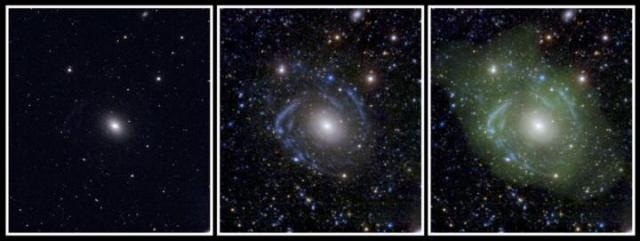Jul 12 2016
Astronomers have believed since the 1960s that a galaxy dubbed UGC 1382 was a relatively boring, small elliptical galaxy. Ellipticals are the most common type of galaxy and lack the spiral structure of disks like the Milky Way we call home. Now, using a series of multi-wavelength surveys, astronomers, including Carnegie's Mark Seibert, Barry Madore and Jeff Rich, have discovered that it is really a colossal Giant Low Surface Brightness disk galaxy that rivals the champion of this elusive class--a galaxy known as Malin 1. Malin 1 is some 7 times the diameter of the Milky Way. The research is published in the Astrophysical Journal.
 At left, in optical light, UGC 1382 appears to be a simple elliptical galaxy. But spiral arms emerged when astronomers incorporated ultraviolet and deep optical data (middle). Combining that with a view of low-density hydrogen gas (shown in green at right), scientists discovered that UGC 1382 is gigantic. (CREDIT: NASA/JPL/Caltech/SDSS/NRAO/L. Hagen and M. Seibert)
At left, in optical light, UGC 1382 appears to be a simple elliptical galaxy. But spiral arms emerged when astronomers incorporated ultraviolet and deep optical data (middle). Combining that with a view of low-density hydrogen gas (shown in green at right), scientists discovered that UGC 1382 is gigantic. (CREDIT: NASA/JPL/Caltech/SDSS/NRAO/L. Hagen and M. Seibert)
Giant Low Surface Brightness galaxies are among the most massive and isolated spiral galaxies known. They are very rare and have two components: what is known as a high surface brightness disk galaxy, with an extended low surface brightness disk surrounding it. So why was galaxy UGC1382 so misconstrued before?
Seibert explains: "Although there have been numerous surveys of the now-defunct elliptical since it was first cataloged in the 1960s, the only indication that it may be an unusual system was in 2009 when another survey indicated that there may be a hint of a rotating hydrogen disk, but it was not followed up. UGC 1382 came to our attention while we were looking at star formation in early-type galaxies using NASA's Galaxy Evolution Explorer (GALEX). We saw that in the ultraviolet part of the spectrum spiral arms were visible--something you do not expect to see around elliptical galaxies. Naturally, that finding sent us off on a very different path!"
Further investigation revealed that the hydrogen disk was real and has an enormous width. For comparison, our own Milky Way Galaxy has a width of 30 kiloparsecs (kpc), but UGC1382 is 220 kpc wide-about 7 times as large as the Milky Way. Despite the huge difference in size, the two systems weigh roughly the same. That is, they have very similar amounts of stars and gas.
Lea Hagen the lead author--a graduate student at the Pennsylvania State University and a former Carnegie summer student remarked, "It's unusual and surprising that we would have such a well-studied galaxy and miss its most unique property: a huge set of spiral arms. The fact that the spiral arms and hydrogen gas extend so far compared to most other galaxies makes this an exciting object for understanding the most extreme examples of galaxy evolution."
"A particularly attractive feature of the newly reclassified UGC 1382 is that it is much closer to us than Malin 1, about a quarter of the distance, in fact," remarked Seibert. "That proximity is what allowed us to conduct the multi-wavelength investigation and it will allow us to start to unravel how these extreme systems form and evolve. We know that such objects need to have a low-density environment without other large galaxies nearby that would disturb it, but they also need a supply of small but gas-rich 'dwarf' galaxies to accrete and build the really large diffuse extended disk. Unlike typical galaxy formation, however, the outer blue spiral disk appears to be older than the inner red disk. That is a big clue about how you get oddball giants like this."
Thus far, there have been about a dozen Giant Low Surface Brightness galaxies found, but none more extreme in size than Malin 1, which now has a rival in UGC 1382. The proximity of UGC 1382 will be a boon to revealing other features of such elusive giants in addition to understanding other seemingly normal early galaxies. The increased sensitivity of future telescopes and instruments may yield yet more discoveries of other misclassified galaxies.